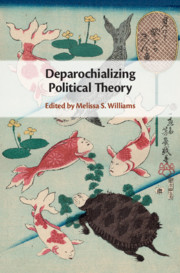45 results
Agricultural Research Service Weed Science Research: Past, Present, and Future
-
- Journal:
- Weed Science / Volume 71 / Issue 4 / July 2023
- Published online by Cambridge University Press:
- 16 August 2023, pp. 312-327
-
- Article
-
- You have access
- Open access
- HTML
- Export citation
Timely intervention and control of a novel coronavirus (COVID-19) outbreak at a large skilled nursing facility—San Francisco, California, 2020
- Part of
-
- Journal:
- Infection Control & Hospital Epidemiology / Volume 42 / Issue 10 / October 2021
- Published online by Cambridge University Press:
- 14 December 2020, pp. 1173-1180
- Print publication:
- October 2021
-
- Article
-
- You have access
- Open access
- HTML
- Export citation
Copyright page
-
- Book:
- Deparochializing Political Theory
- Published online:
- 15 March 2020
- Print publication:
- 02 April 2020, pp iv-iv
-
- Chapter
- Export citation
Tables
-
- Book:
- Deparochializing Political Theory
- Published online:
- 15 March 2020
- Print publication:
- 02 April 2020, pp ix-ix
-
- Chapter
- Export citation
Contributors
-
- Book:
- Deparochializing Political Theory
- Published online:
- 15 March 2020
- Print publication:
- 02 April 2020, pp x-xii
-
- Chapter
- Export citation
Note on the Text
-
- Book:
- Deparochializing Political Theory
- Published online:
- 15 March 2020
- Print publication:
- 02 April 2020, pp xx-xx
-
- Chapter
- Export citation
8 - Deparochializing Democratic Theory
-
-
- Book:
- Deparochializing Political Theory
- Published online:
- 15 March 2020
- Print publication:
- 02 April 2020, pp 201-229
-
- Chapter
- Export citation
Index
-
- Book:
- Deparochializing Political Theory
- Published online:
- 15 March 2020
- Print publication:
- 02 April 2020, pp 291-306
-
- Chapter
- Export citation
1 - Introduction
-
-
- Book:
- Deparochializing Political Theory
- Published online:
- 15 March 2020
- Print publication:
- 02 April 2020, pp 1-24
-
- Chapter
- Export citation
Contents
-
- Book:
- Deparochializing Political Theory
- Published online:
- 15 March 2020
- Print publication:
- 02 April 2020, pp vii-viii
-
- Chapter
- Export citation
Dedication
-
- Book:
- Deparochializing Political Theory
- Published online:
- 15 March 2020
- Print publication:
- 02 April 2020, pp v-vi
-
- Chapter
- Export citation
Preface and Acknowledgments
-
- Book:
- Deparochializing Political Theory
- Published online:
- 15 March 2020
- Print publication:
- 02 April 2020, pp xiii-xix
-
- Chapter
- Export citation

Deparochializing Political Theory
-
- Published online:
- 15 March 2020
- Print publication:
- 02 April 2020
26 - Compositional and Mineralogic Analyses of Mars Using Multispectral Imaging on the Mars Exploration Rover, Phoenix, and Mars Science Laboratory Missions
- from Part IV - Applications to Planetary Surfaces
-
-
- Book:
- Remote Compositional Analysis
- Published online:
- 15 November 2019
- Print publication:
- 28 November 2019, pp 513-537
-
- Chapter
- Export citation
Egalitarianism and the Epistemic Standards of Public Reason - Cécile Laborde: Liberalism's Religion. (Cambridge, MA: Harvard University Press, 2017. Pp. 344.)
-
- Journal:
- The Review of Politics / Volume 81 / Issue 4 / Fall 2019
- Published online by Cambridge University Press:
- 11 September 2019, pp. 645-648
-
- Article
- Export citation
Multiscale Cardiac Imaging: From Whole Heart Images to Cardiac Ultrastructure
-
- Journal:
- Microscopy and Microanalysis / Volume 25 / Issue S2 / August 2019
- Published online by Cambridge University Press:
- 05 August 2019, pp. 1198-1199
- Print publication:
- August 2019
-
- Article
-
- You have access
- Export citation
3DEM Data Collection of Cancer Biopsies: Comparing FIB-SEM and SBF-SEM
-
- Journal:
- Microscopy and Microanalysis / Volume 25 / Issue S2 / August 2019
- Published online by Cambridge University Press:
- 05 August 2019, pp. 1194-1195
- Print publication:
- August 2019
-
- Article
-
- You have access
- Export citation
Correlative Light and 3D Electron Microscopy of Subnuclear Structures.
-
- Journal:
- Microscopy and Microanalysis / Volume 24 / Issue S1 / August 2018
- Published online by Cambridge University Press:
- 01 August 2018, pp. 1222-1223
- Print publication:
- August 2018
-
- Article
-
- You have access
- Export citation
Toleration's Prudential Calculus - Teresa M. Bejan: Mere Civility: Disagreement and the Limits of Toleration. (Cambridge, MA: Harvard University Press, 2017. Pp. 272.)
-
- Journal:
- The Review of Politics / Volume 80 / Issue 3 / Summer 2018
- Published online by Cambridge University Press:
- 20 June 2018, pp. 515-517
-
- Article
- Export citation
Advantages of Using a Variable Pressure Serial Block Face Scanning Electron Microscope for 3D Volume Analyses
-
- Journal:
- Microscopy and Microanalysis / Volume 23 / Issue S1 / July 2017
- Published online by Cambridge University Press:
- 04 August 2017, pp. 1162-1163
- Print publication:
- July 2017
-
- Article
-
- You have access
- Export citation



